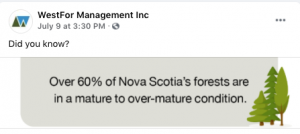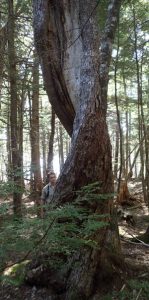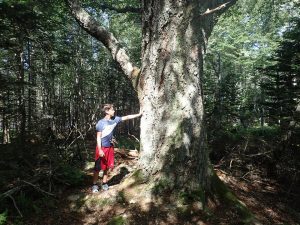 An Oh-Oh statement by WestFor stimulates discussion of use of the term”over mature” to describe a forest stand.
An Oh-Oh statement by WestFor stimulates discussion of use of the term”over mature” to describe a forest stand.
I thought even foresters didn’t use this term any more, especially following the Lahey Report. From that report (bolding inserted)
51. Analysis of the framework, particularly of the Forest Management Guide and decision keys, suggests that it does not encourage but limits multi‐aged silvicultural prescriptions. The following is a list of examples written by Dr Robert Seymour of the Review team: a. The first node in many keys is whether or not the stand is “over‐mature.” This pejorative term is a relic of a past era when efficient, economically driven timber management sought to create forest structures devoid of biologically old trees, and is no longer used in scientific literature or textbooks. Table 4 of the Guide (page 15) attempts to define over‐maturity using tree ages that are often only one‐third or less the lifespan of the species. For example, if a hemlock forest is over age 100, it is deemed “over‐mature” and unsuitable for multi‐aged silviculture, and is instead sent to the “Regenerate” key, where complete overstory removal is prescribed once advance regeneration is present. Such a complete disturbance in a biologically young (hemlock lives to age 400–500) hemlock forest would be virtually unprecedented in nature.
A recent discussion of “over mature” began with this post on WestFor’s public Facebook page on July 9, 2021:
Comments on the post on WestFor FB Page:
CB: Please quote reputable chapter and verse completely.
MB: Purely anthropocentric viewpoint
TD: Maybe you can convince the city people. 🤣😂🤣
Ain’t gonna work on the country folk who can see the clear cuts from the roads.
TB:
Maybe in human years, but in tree years more line .06%.
SS:
So misleading!
EH: Wow over mature. I call for restoring forests to natural states. Maybe finding the mother tree by Scientist Susan Simard should be mandatory reading for you all. Check out wildwood ecoforestry in Nanaimo. https://www.ecoforestry.ca/
We can and must do forestry differently and better. We are right now in a climate and biodiversity crisis. In BC our waterways are drying up very early in the season. Farmers losing food crops. Fish frey dying. Shoreline seafood dying in their shells. What more needs to happen before industry has morales
On Healthy Forest Coalition public Facebook Page, post July 14
ML: In case anyone is contemplating this [WestFor post] claim:
The use of the term “over-mature” to describe a forest ecosystem, and subsequently justify large-scale harvesting, is to view the forest through a lens that predominantly views status quo economic considerations.
Ecology, community, restoration economy, and recreation are secondary under this lens.
The term is generally used to describe forests that have reached, or surpassed, their peak of viability as a traditional economic product, usually lumber.
Even describing a forest as “mature” is often inappropriate when multiple values are considered. However, the classification can be applied to other values, such as assessing habitat potential for Species at Risk.
Perhaps the best way to see how these concepts are inappropriately applied is how eastern hemlock, red spruce, sugar maple, and yellow birch would all be considered to be “over mature” if they exceed the age of 100 yet all of these species are known to exceed ages of 300. It’s the equivalent of saying 30 year old humans are “over mature”.
Simply put, a forest is never ‘so old that it must be fully cut’ and the term should have extremely limited weight in the application of true ecological forestry.
TB: To make this same point to my students in Forestry and Environmental Management at UNB, I ask my students, “At what point do you consider your precious grandparents to be ‘overmature'”?
AF: well just like this province if there are no young around and the old are all down and cant get up its overmature most of the time this is a result of even age stands in old fields…much like are population space needs to be made for the young with the old dominating the space and taking all the sun there is no space for young to grow up i dont point this out to justify clear cutting only to point out that poor practices and planing of the past has lead us here its time to come up with a good forestry plane

Old trees support biodiversity and store carbon. Raymond Plourde spotted this one. The tree is an old wind-twisted red maple in Old Forest by Sandy Lake (Bedford, N.S.) on Sep 15, 2019.
GW: Lahey stated our forests are in poor shape. Various numbers or percentages never describe the health of the system. Forests are systems that don’t function based on our interpretation of age classes or maturity levels. A lot could be learned from “listening to the forests”
AF: i have spent lots of time cutting overmature stands it is a real problem on old farms abandond 80 years ago grown up in one age of w spruce then it all falls at once if work had been done one time to ad speices and age diversity it could still be a forest without cutting it all but at some point land owners have to decide if they want to cut it all or do nothing the money is ok and payed my bills the trees were all falling anyway and the land owner did not want the mess of big trees in the way of new growth and made some money at it but these singal age singal tree type stands are not everywhere and if work is done befor its to late a cleacutt can be avoided
BW: One of the things that I find most worrisome about this attitude that most of the trees are overmature so they need to be cut down is that those who are advocating for all of this cutting are assuming that the trees are going to grow back the same as they used to do. I was just reading an article this morning in which they interviewed several people who are forest managers, Forest Services, etc.. in the U.S. and Canada, and they all said that the forests are not growing back the way they should — that the regrowth is more shrubs, brush and other plants. These people have been in forestry for years and said they never expected to see this much change, but that it has happened really quickly. Well, just after I read that article, I noticed a post by Todd Labrador on a group about traditional knowledge, etc.. and he mentioned that the Birch still have their “winterbark” in July and this is something he has noticed. A couple of other people in the group mentioned it is happening in New Brunswick as well and so it is not just him that has noticed it. From what I understand, winterbark used to be harvested in winter and that once spring came and there was sap and moisture moving in the trees, the bark couldn’t be removed the way it can be in winter. That actually kind of jives with one of the forest managers in the west who said that the Pines can’t defend themselves from the bark beetles — that normally they push out pitch that defends the tree, but they are too dry and can’t produce the pitch that protects them. I think about the forests I know in Ontario — I was back there for a year from summer 2016 to late summer 2017. While I was there, I went out to hike around in some of the forests that my late husband and I used to hike in frequently before I moved out east after he died. He died in 2008 and I was there in 2016, so that’s only 8 years. The amount of dead trees that I saw there was just mind boggling — trees I knew individually as they were favourite trees along many trails – and there they were, all lying dead and decaying on the ground — not just one species or age, but many in several species. I also noticed how the leaves in the forests were so dry in Sept — faded pale brown and splotched with tar spot and other fungal diseases and they were curled and falling — trees that normally were wonderful in autumn. It all made me sad and I could tell there was something not right with the forests — and now i’m reading just that same thing by forestry ecologists and managers. So, what are we doing — we’re chopping down perfectly healthy trees — creating vast areas of exposed ground that will leach off nutrients and also super-heat in the intense sunlight and cause even more heat and drying. I can’t believe how this is being permitted and even encouraged to continue. This has all the signs of a sick society that isn’t even paying attention to the natural world around us.
GW to BW: we are noticing trees are lighter hense less moisture in them. I’m finding there have stress indicators the last 5 or 6 years with the drought conditions we’ve had
MW to BW:Marian Whitcomb
Bev Wigney I totally confirm your findings, having lived in South Florida, the Deep South, the Midwest, Pacific Northwest, and now here. Add to the cutting the impact of non-native insects, plants, and disease, I wonder how we can push the snowball back up the slope. Was looking yesterday at a stand of “mature” dead beech totally dominated by hybridized hawkweed (which dominates diverse understory plants through a chemical competitive process called “allelopathy”), and thinking…THIS is not Nova Scotia any more, and never will be again. I wish more people understood these things. Instead, they say, “look at all the pretty yellow flowers,” and go on with their busy lives. (this is an older photo, the hawkweed was dominating before the leaf mining weevil, but now that the trees are dying and more sun is coming in, they are far worse than this)
KG: If any private woodland is overmature it’s likely because the landowners don’t want it clear-cut, and I’m sorry to say no contactors know how or will do decent selection cutting, it all about flatten it as quickly as possible..banks and government especially love quick money.
.and we all know what the”love of money” creates!!
VW: Just discussing that with a friend who lives on the North Mountain — her family has been over there for over 200 years. A truck just went by yesterday carrying a huge harvester — leaving — somewhere past her place, it must have been working for the past couple of weeks as there have been a bunch of unmarked trucks hauling out logs — at least one was a B-train — obviously,, someone over there just had a whole forest cut down. What’s interesting is that a woman contacted me who bought land over in the same area. She has had it for 20 years now. When she bought it, she didn’t go all around over it, but when she did, she found out that a big part of it was clearcut already — had been awhile ago. NONE of that part of her land has started to regrow — that is about 25 years ago now. I looked at the area on google satellite and it’s just looks like the moon. There’s a lot of land that looks like that now in parts of NS.
AF: often i see lots that were cleared 80-100 years back then grown up even aged land owners see lots of dead fallen trees and call in the contractor to cut it all and the problem is passed on if land owners had trusted reliable people to advise and a good plan small patch cuts or selectiv logging could let some light in and get some regen going befor its to late .select cut wood compeating on the market with clear cut wood makes it much harder on forests and people if the crown would stop selling wood and consumers demanded loacal select cut we could turn things around have jobs and nice forests


